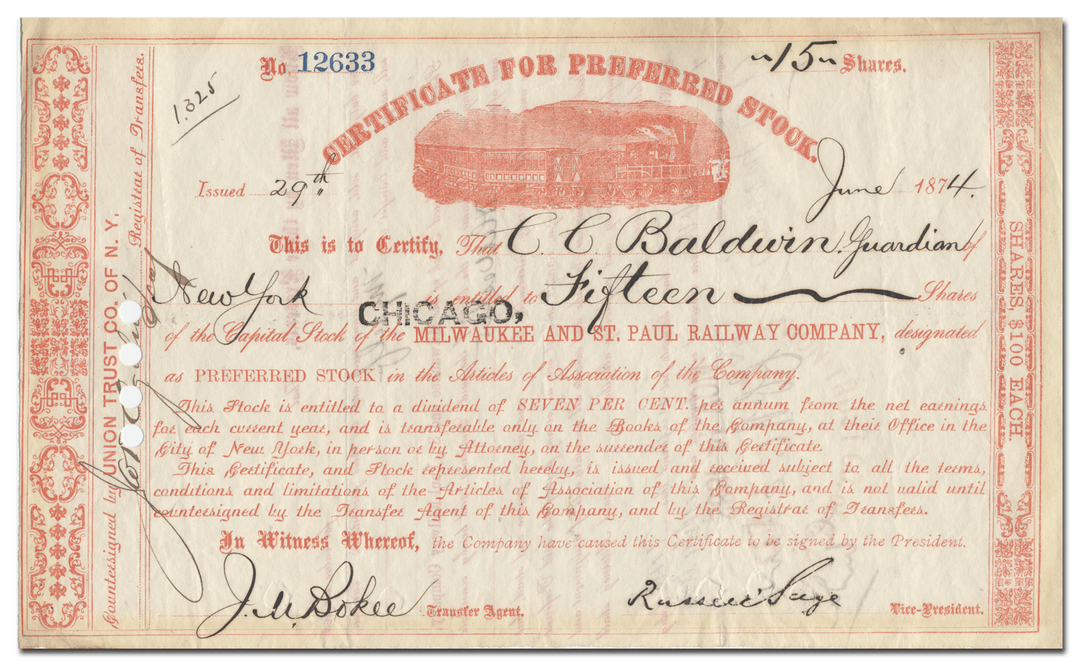
Chicago, Milwaukee and St. Paul Railway Company (Signed by Russell Sage)
- Guaranteed authentic document
- Orders over $75 ship FREE to U. S. addresses
You will receive the exact certificate pictured
Over 125 years old
Capital stock
June 29, 1874
Issued, canceled
Not indicated
Hand signed
9 3/4" (w) by 5 3/4" (h)
Signed by Russell Sage.

Sage was born at Verona in Oneida County, New York. He received a public school education and worked as a farm hand until he was 15. He started as an errand boy in his brother Henry's grocery in Troy, New York. He had a part interest in 1837–1839 in a retail grocery in Troy, and in a wholesale store there in 1839–1857.
Political Career
In 1841 Sage was elected as alderman in Troy. He was re-elected to this office until 1848, while also serving for seven years as treasurer of Rensselaer County. He was elected to the U.S. House of Representatives as a Whig, and served, with re-election as an Oppositionist, from March 4, 1853 until March 3, 1857. He served on the Ways and Means Committee. Sage was the first person to advocate in Congress for the purchase of George Washington's plantation, Mount Vernon, by the government.
Subsequently, Sage settled in New York City, and engaged in the business of selling puts and calls and privileges on Wall Street.
Olivia Slocum Sage
In 1869, Sage was involved in a legal case concerning the usury laws in New York state, in which he was accused of being the leader of a usury group. He was convicted and fined $500, but his jail sentence was suspended. That year he remarried, to Olivia Slocum of Syracuse, New York.
Financial Career
Sage bought a seat on the New York Stock Exchange in 1874, and became known as a financier. At the same time he saw the future of railroads, and secured stocks in western roads, notably the Chicago, Milwaukee and St. Paul Railway. He was president and vice-president for twelve years. By selling such investments, as the smaller roads were bought by major trunk-lines, he became wealthy.![]() In his later years Sage was closely associated with Jay Gould in the management of the Wabash Railway, St. Louis and Pacific, Missouri Pacific Railroad, Missouri-Kansas-Texas Railroad, Delaware, Lackawanna and Western Railroad and the St. Louis - San Francisco Railway, for which he was director of the corporations. He also served as director for the American cable company, the Western Union Telegraph Company, and the Manhattan consolidated system of elevated railroads in New York City.
In his later years Sage was closely associated with Jay Gould in the management of the Wabash Railway, St. Louis and Pacific, Missouri Pacific Railroad, Missouri-Kansas-Texas Railroad, Delaware, Lackawanna and Western Railroad and the St. Louis - San Francisco Railway, for which he was director of the corporations. He also served as director for the American cable company, the Western Union Telegraph Company, and the Manhattan consolidated system of elevated railroads in New York City.
Sage was also a director of the Union Pacific Railroad, which was part of constructing the transcontinental railroad. Together with other major investors (and railroad robber barons of the nineteenth century), he made a fortune. He was a director and vice-president in the Importers and Traders' National Bank for twenty years, and also a director in the Merchants' Trust Company and in the Fifth Avenue Bank of New York City.
Assassination Attempt
In 1891, Henry L. Norcross entered the office of Sage at 71 Broadway in Manhattan, claiming he needed to discuss railroad bonds. Norcross gave Sage a letter demanding $1,200,000, which Sage declined to pay. Norcross was carrying a bag of dynamite, which exploded, killing Norcross, wounding Sage, and severely wounding William R. Laidlaw, Jr., a clerk for John Bloodgood and Co. who happened to be in the office. Afterward Laidlaw sued Sage, alleging that he had used him as a shield against Norcross. Disabled for life, Laidlaw aggressively pursued the lawsuits, winning $43,000 in damages after four trials, but a Court of Appeals reversed the award. Sage never paid any settlement and was publicly criticized as a miser because of his great fortune.
Legacy and Honors
Olivia Sage devoted a major portion of the money she inherited from her husband to philanthropy, including buildings and other memorials to him. She commissioned Ralph Adams Cram, a leading architect, to design Russell Sage Memorial Church, and for Louis Tiffany to create a large stained glass window as a memorial. Built in 1908, the church was located in Far Rockaway, Queens, where the family had a summer home.
In 1907 she established the Russell Sage Foundation, and in 1916 founded Russell Sage College in Troy, New York. In addition she gave extensively to the Emma Willard School and to Rensselaer Polytechnic Institute (RPI) in Troy, her husband's home town.
During World War II the Liberty ship SS Russell Sage was built in Panama City, Florida, and named in his honor.
Additional Information
Certificates carry no value on any of today's financial indexes and no transfer of ownership is implied. All items offered are collectible in nature only. So, you can frame them, but you can't cash them in!
All of our pieces are original - we do not sell reproductions. If you ever find out that one of our pieces is not authentic, you may return it for a full refund of the purchase price and any associated shipping charges.





